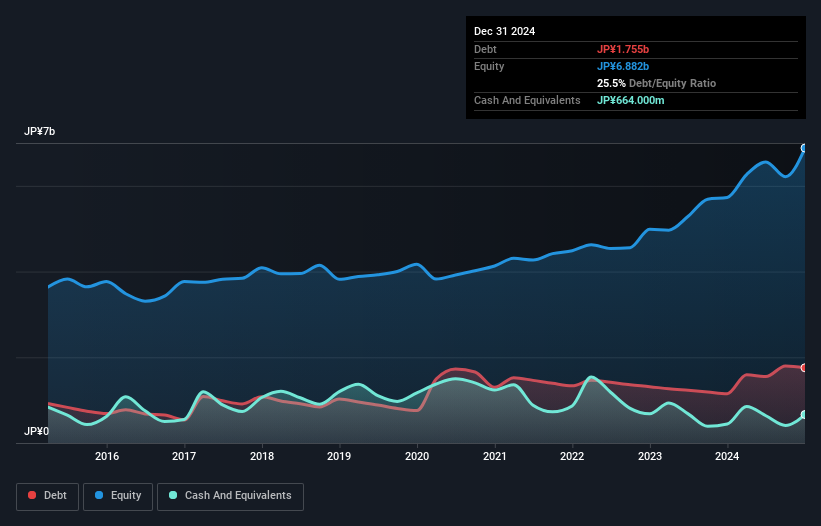- Japan
- /
- Infrastructure
- /
- TSE:9353
We Think Sakurajima Futo Kaisha (TSE:9353) Is Taking Some Risk With Its Debt
Legendary fund manager Li Lu (who Charlie Munger backed) once said, 'The biggest investment risk is not the volatility of prices, but whether you will suffer a permanent loss of capital.' When we think about how risky a company is, we always like to look at its use of debt, since debt overload can lead to ruin. Importantly, Sakurajima Futo Kaisha, Ltd. (TSE:9353) does carry debt. But the more important question is: how much risk is that debt creating?
What Risk Does Debt Bring?
Debt and other liabilities become risky for a business when it cannot easily fulfill those obligations, either with free cash flow or by raising capital at an attractive price. Ultimately, if the company can't fulfill its legal obligations to repay debt, shareholders could walk away with nothing. However, a more usual (but still expensive) situation is where a company must dilute shareholders at a cheap share price simply to get debt under control. Of course, plenty of companies use debt to fund growth, without any negative consequences. The first step when considering a company's debt levels is to consider its cash and debt together.
What Is Sakurajima Futo Kaisha's Debt?
You can click the graphic below for the historical numbers, but it shows that as of December 2024 Sakurajima Futo Kaisha had JP¥1.76b of debt, an increase on JP¥1.15b, over one year. On the flip side, it has JP¥664.0m in cash leading to net debt of about JP¥1.09b.

How Healthy Is Sakurajima Futo Kaisha's Balance Sheet?
Zooming in on the latest balance sheet data, we can see that Sakurajima Futo Kaisha had liabilities of JP¥1.05b due within 12 months and liabilities of JP¥2.97b due beyond that. Offsetting these obligations, it had cash of JP¥664.0m as well as receivables valued at JP¥1.12b due within 12 months. So its liabilities outweigh the sum of its cash and (near-term) receivables by JP¥2.23b.
This is a mountain of leverage relative to its market capitalization of JP¥2.31b. Should its lenders demand that it shore up the balance sheet, shareholders would likely face severe dilution.
See our latest analysis for Sakurajima Futo Kaisha
We measure a company's debt load relative to its earnings power by looking at its net debt divided by its earnings before interest, tax, depreciation, and amortization (EBITDA) and by calculating how easily its earnings before interest and tax (EBIT) cover its interest expense (interest cover). Thus we consider debt relative to earnings both with and without depreciation and amortization expenses.
We'd say that Sakurajima Futo Kaisha's moderate net debt to EBITDA ratio ( being 1.6), indicates prudence when it comes to debt. And its strong interest cover of 1k times, makes us even more comfortable. On top of that, Sakurajima Futo Kaisha grew its EBIT by 46% over the last twelve months, and that growth will make it easier to handle its debt. The balance sheet is clearly the area to focus on when you are analysing debt. But it is Sakurajima Futo Kaisha's earnings that will influence how the balance sheet holds up in the future. So if you're keen to discover more about its earnings, it might be worth checking out this graph of its long term earnings trend .
Finally, a business needs free cash flow to pay off debt; accounting profits just don't cut it. So the logical step is to look at the proportion of that EBIT that is matched by actual free cash flow. During the last three years, Sakurajima Futo Kaisha burned a lot of cash. While that may be a result of expenditure for growth, it does make the debt far more risky.
Our View
While Sakurajima Futo Kaisha's conversion of EBIT to free cash flow has us nervous. For example, its interest cover and EBIT growth rate give us some confidence in its ability to manage its debt. We should also note that Infrastructure industry companies like Sakurajima Futo Kaisha commonly do use debt without problems. We think that Sakurajima Futo Kaisha's debt does make it a bit risky, after considering the aforementioned data points together. That's not necessarily a bad thing, since leverage can boost returns on equity, but it is something to be aware of. When analysing debt levels, the balance sheet is the obvious place to start. But ultimately, every company can contain risks that exist outside of the balance sheet. For example - Sakurajima Futo Kaisha has 1 warning sign we think you should be aware of.
If, after all that, you're more interested in a fast growing company with a rock-solid balance sheet, then check out our list of net cash growth stocks without delay.
New: Manage All Your Stock Portfolios in One Place
We've created the ultimate portfolio companion for stock investors, and it's free.
• Connect an unlimited number of Portfolios and see your total in one currency
• Be alerted to new Warning Signs or Risks via email or mobile
• Track the Fair Value of your stocks
Have feedback on this article? Concerned about the content? Get in touch with us directly. Alternatively, email editorial-team (at) simplywallst.com.
This article by Simply Wall St is general in nature. We provide commentary based on historical data and analyst forecasts only using an unbiased methodology and our articles are not intended to be financial advice. It does not constitute a recommendation to buy or sell any stock, and does not take account of your objectives, or your financial situation. We aim to bring you long-term focused analysis driven by fundamental data. Note that our analysis may not factor in the latest price-sensitive company announcements or qualitative material. Simply Wall St has no position in any stocks mentioned.
About TSE:9353
Sakurajima Futo Kaisha
Engages in the port transportation business in Japan.
Solid track record with excellent balance sheet and pays a dividend.
Market Insights
Community Narratives




